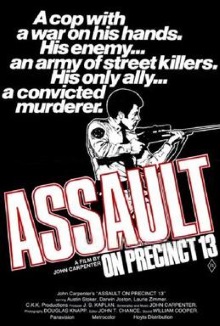
Assault on Precinct 13 is a film that pops up from time to time in discussions of influential action movies in places like Broken Forum. This was only the second film made by John Carpenter and helped cement his reputation in Hollywood for being a director capable of making decent films on a very tight budget. I think it’s also remarkable that it stars a black man as the hero while being very much not a blaxploitation flick. Played by Austin Stoker, the character is a police officer who happens to be black, but his blackness isn’t emphasized by the film.
Stoker is Ethan Bishop, a newly promoted lieutenant who is assigned to watch over a police station that is being decommissioned. Around the same time, the city is being terrorized by a local gang who have stolen a large number of powerful firearms. It also just happens that a trio of prisoners, including convicted murderer Napoleon Wilson, are being transported to jail but an illness causes their bus to divert to the old police station. When the gangsters kill a little girl on the street, the aggrieved father kills one of them in return and then flees to the station. In response, the entire gang musters and lays siege to the police station, cutting off all communications and access. The initial assault kills just about all of the other remaining police officers, forcing Bishop to free the prisoners to help him hold out against the crazed gang members.
This film has a very slow build-up and throws up enough red herrings to leave me confused as to its direction. For a while there I honestly thought that Wilson has engineered the whole thing to break out of prison. But then the film had me wrong-footed right from the beginning. It opens with a scene of young, armed gangsters sneaking through a building only to be gunned down to the last man by the police. Seen with today’s eyes, this can only be interpreted as a statement about police brutality but I forgot that this was made in the 1970s when everybody was panicking about hyper-violent criminals. That’s why the film plays it completely straight and makes it clear that this level of violence is justified. Indeed, the gangsters, a strangely diversified group of multiple ethnicities, are portrayed here as being barely human. At times, they move in a kind of inexorable shamble. Other times, they’re more like ghosts. It’s no surprise that Carpenter claims he was inspired by the zombies in Night of the Living Dead.
The action is passable but unremarkable. The best thing about this film is I think is it’s unusual pacing and how it ramps up perfectly in sync with the funky music that Carpenter composed himself. Plenty of plot elements stretch credibility even if the characters lampshade them, such as how this could pass unnoticed in the middle of a large American city. On balance, I found this to be a film that may be significant to filmmakers and producers but has little to offer to modern audiences. One thing that is certain is that audiences today are much more skeptical of police authority so it would be impossible to make a film like this now.